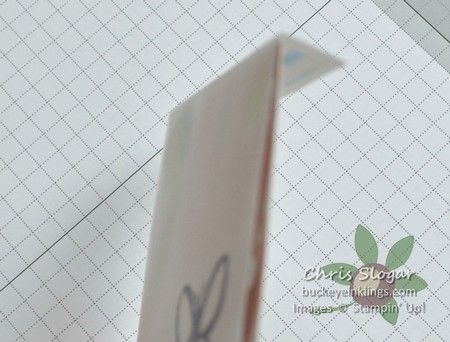Vellum adds a special touch to your projects without a lot of extra fuss. These are the two cards we made in club this weekend using vellum – quite easy in terms of construction, but the vellum makes them more sophisticated.
This second card is a case from page 119 of the Annual Catalog. Both cards use the “Garden in Bloom” stamp set and English Garden designer series paper.
The best features of vellum are also the biggest challenges when using it. We love that frosty, transparent look, but the transparency forces some planning when it comes to adhesive. I don’t like to see adhesive through the vellum, so I find ways to hide it.
On my first card, I used a small bit of snail adhesive at the top left corner of the squares as a temporary measure, and then I stapled through both squares, catching the Silver Metallic Thread loops. I hid this attachment behind the banner.
The second card has an extra 1/2″ flap of vellum that wraps to the back of the designer paper. I used sticky strip along that flap to attach the vellum panel.
Vellum is a coated material, not at all porous, so it doesn’t allow ink to soak in. Our Classic ink does dry on vellum, but it takes longer. Heat embossing, as shown on the first card, is ideal for vellum, and it looks great! I colored the flower from the back with Stampin’ Write markers.
StazOn is a great ink for vellum, and that is what you see on the butterfly card. It dries more quickly than other inks, and it is very opaque. StazOn, and especially StazOn cleaner, can break down photopolymer, though. Stampin’ Up! recommends using StazOn cleaner sparingly, and removing all traces of the cleaner with an additional wash.
If you are concerned and would like to read more about StazOn and polymer, I found the following info at photocentricusa.com. It convinced me that I could accept the risk of StazOn. If the stamps can hold up to repeated use (stamping many times a minute) for months with StazOn, I think mine will be able to weather my limited StazOn use! It would be a shame if we couldn’t use our stamps for all of our needs. Anyway, well-used stamps make me just as happy as pristine stamps – they each have their own appeal, don’t they?
From photocentricusa.com…
“Polymer is like us in that it doesn’t like too much sunlight or too much alcohol! The solvent in Staz-on is amongst the most aggressive on polymer stamps and will attack the upper surface on contact. This gives the stamp more grab on the paper and makes it feel sticky when removed. In reality, the solvent is only affecting the stamp whilst it’s liquid, which is only for a few seconds before it evaporates and even then only the thinnest surface of the stamp. After repeated stamping this effect is reduced as the stamp becomes protected by a layer of pigment. We use performed long term trials with Staz-on on polymer stamps, and even with repeated use (stamping many times a minute) they still last for many months.
Recommendations for using solvent based inks with clear stamps
1. Use solvent based cleaners sparingly. Solvent based cleaners are more damaging to the stamp than the ink you are removing. So if you can use cleaners, do so sparingly.
2. Create a pigment barrier between the polymer and ink by applying a water based ink before applying your solvent ink. This will prevent the solvents from coming into direct contact with the polymer.
3. Wash ink off immediately with soapy water.
Solvent based inks
Solvent inks are great for permanent strong inking, we recommend Staz-on. They impart very minor damage to the photopolymer. The solvent cleaners will eventually damage the polymer.”
Thanks for stopping by – have a great Monday!




